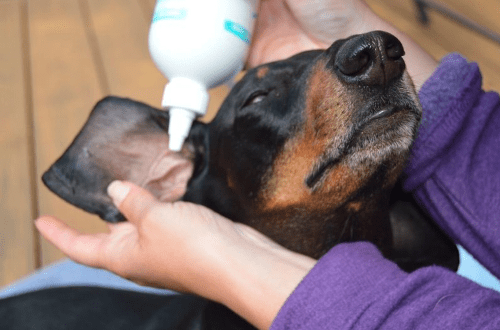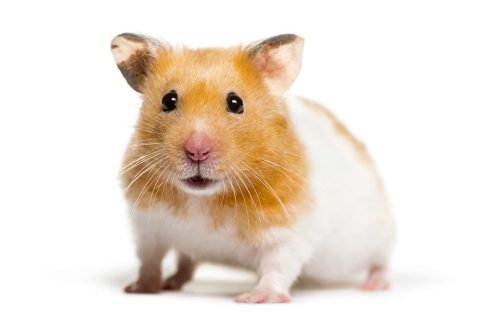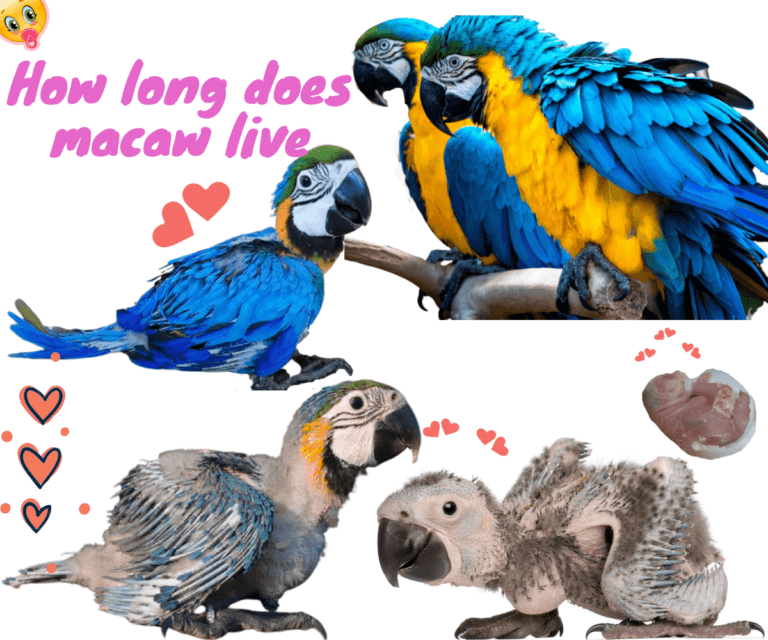
Macaw parrot: how long do they live, content, types, colors, training
The macaw parrot is a kind of champion. This is one of the largest, brightest, sociable and intelligent birds that nature has ever created. To come into contact with such a feathered one is a real honor! This is the experience that is unforgettable. Today we offer to learn more about the macaw – it’s definitely worth it.
Contents
- Macaw parrot: how did it appear
- Habitat of the Macaw parrot
- Appearance of the Macaw parrot: general characteristics
- Types of parrot Macaw
- About extinct species: this too interesting
- Character and features bird behavior
- Care and maintenance of the Macaw parrot home: what is important to know
- Macaw parrot training: secrets and nuances
- Macaw parrot breeding: nuances
- Diseases of the Macaw parrot: let’s talk about the main ailments
Macaw parrot: how did it appear
About in 2018, information appeared that that scientists, having isolated DNA from ancient macaw remains, decided to find out the origin this bird. Sounds intriguing, doesn’t it? right? And so, it turned out that one of the first ancestors these birds appeared on the territory current Mexico. And even then they were kept at home conditions, oddly enough.
Breeding ancestors of modern macaws were engaged ancestors of modern northerners regions of Mexico and southwestern North America. Even before these lands the foot of a white man set foot, the Indians found a common language with these birds. They borrowed their feathers for ornaments and outfits, depicted a macaw at any convenient case on the dishes. In a word, honored as much as they could.
INTERESTING: A person who wore macaw feathers was considered to enjoy a special status.
It and no wonder: if we are struck dimensions, intelligence and brightness of this bird, then what about ancient people? Yes and longevity of their amazing creatures could not but impress, especially against the background how long people lived then. Scientists found out that they enjoyed special honor scarlet parrots. And again, it makes sense: scarlet – the color of energy, victory in battle, personification of speed and power. In a peaceful understanding, he is happiness, joy, beauty.
When Europeans met with macaws, the latter were also impressed. В in particular, in XVI century, this bird was not only mentioned one famous scientist – Hargrove – but and dedicated an entire book to her! imported to the US and Europe, these parrots have received quite popular in as pets. repeated wave expected popularity and distribution these birds after World War II, when the cost of air travel went down, and interest in breeding birds, on the contrary, has grown.
Habitat of the Macaw parrot
Where today you can meet these beautiful birds? In the tropics, of course! This beauty adorns the forests of Central and South America near large bodies of water. The Caribbean islands are another a place where travelers can smile luck in the form of macaws. Only for this will have to be raised head – macaws are most loved sit at the top of the tropical trees.
Give also a little tip about where to see the view:
- blue-yellow – in Panama, Paraguay, Brazil;
- green-winged – all over South America
- red and soldier – in Central America;
- Nicaraguan – of course, in Nicaragua, as well as in Costa Rica, Panama;
- blue-throated – in Bolivia. More precisely, mostly in its northern region;
- hyacinth and red-eared – also in Bolivia, and the first also in Paraguay, Brazil;
- blue-fronted – throughout the Amazon basin;
- chestnut-haired – in Panama, central and western regions of Brazil, central and northern regions of Bolivia;
- soldier’s small – in Mexico, Bolivia, Colombia;
- yellow neck in Brazil, Argentina, Bolivia, Paraguay;
- redback – also in Paraguay and Brazil;
- blue-headed – in the western part of Peru, northwestern Bolivia, in the east of Bolivia;
- red-bellied – in Brazil, Colombia, Peru, Guyana, southern Venezuela and eastern Ecuador.
Appearance of the Macaw parrot: general characteristics
Как to recognize these wonderful birds?
- The macaw parrot is very large. Sizes vary depending on the species in question. But, as a rule, the gap is from 30 to 100 cm. This refers to the length from the tail to the beak. Accordingly, the weight fluctuates in the same way – on average, it is from 0,9 to 2 kg.
- The plumage is bright, colorful. Moreover, the larger the bird, the brighter its feathers. Miniature macaws are mostly just green, while large ones are variegated. As for gender differences, they do not appear in color. However, even the macaw has “bald” areas. So, in the areas near the eyes and on the cheeks there are no feathers at all. The exception is, perhaps, the hyacinth parrot.
- The beak is another distinguishing feature. Macaws have the strongest beak among all living birds. According to the degree of fortress, it is comparable to a stone. It resembles the shape of a hook, and is compressed on the sides – this is quite convenient when feasting. This beak also has some secret: a miniature outgrowth shelf is hidden in the beak, which allows the macaw to wield its beak in the same way as a person works with his hand. Even difficult to handle and very durable palm nuts, the macaw cracks without problems.
- The tongue always comes to the aid of the beak – it is tenacious, mobile. And if the beak is a hand, the tongue is a kind of finger.
- The larynx is also unique – its structure is similar to the structure of the drum. Thanks to this feature, the macaw masterfully manages to make various sounds. And in imitation of the sounds of macaws there is no equal.
- The eyesight of these birds is monogamous – that is, they are able to see a couple of pictures at the same time in different projections. To give you an idea of how amazing a macaw’s eyesight is, let’s take one example: a human’s viewing speed is a maximum of 24 frames per second, while a macaw’s is 150 frames per second!
- The wings are elongated. They are clearly pointed, which is noticeable to the naked eye.
- The tail is also elongated. It is very long – longer than the body. Shaped like a wedge.
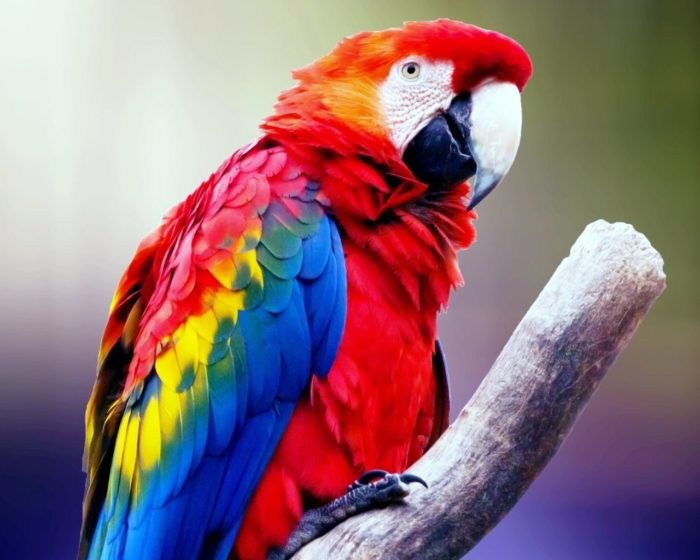
Types of parrot Macaw
А Now let’s talk in more detail about the types between:
- Blue-yellow – a kind of classic image this parrot, familiar to everyone since childhood. Yellow bottom and blue top, small bib black, white area on cheeks with black stripes – This is what the bird looks like. stands out this species is quite large – in length it can reach 90 cm. Unfortunately, the Red Book, despite his inherent caution.
- green-winged – can also reach a length of up to 90 see. The body is painted in saturated red, wings blue and green. On bare cheeks you can see red feathers.
- Red – also known as exotic the names Macau, Aracanga. Also has bright red plumage, but, true, on wings clearly visible row of yellow feathers. There are also green and blue feathers. Distinctive a feature can be called a two-color beak It is light on top and dark on the bottom. On the today is listed in the Red a book.
- soldier – also known as the big green, Buffon – large, grows up to 85-90 cm. Mostly brown-green. However, on the forehead flaunts an impressive red spot, and on the cheeks – a number of small black feathers. On the tail you can see yellow and blue inclusions. beak completely the black.
- blue-throated – another large parrot, which grows up to 85 cm. The body is painted in yellow, but a lot of blue, green feathers. It stands out for its peculiar blue whiskers. The beak is black. Considered a rare species.
- hyacinth – the largest and most expensive representative between. And also belongs to rare. Very big – grows in length even up to 100 cm! Plumage rich blue, and around beak and eyes are unfeathered yellow plots. Cheeks, unlike many other macaws, this one is completely feathered. The beak is gray, which blends harmoniously with blue plumage.
- red-eared – he is also red-faced – another resident of the Red Book. Plumage in the main has a pleasant dark green color, rather olive, and the forehead and shoulder pads – red. There is a circle around the eyes flesh tone. Unlike past giants, this one grows not so large – up to 60 cm.
- Gray – Birds such as голубые – incredibly beautiful parrot with blue-blue plumage. Often it casts a shade of a sea wave. Paws grey, beak dark. Currently not found in the wild at all and there are approximately 500 individuals in captivity. Ornithologists are doing everything they can to save these aquamarine beauties.
- Малый hyacinth – also small blue-fronted – recognized as the smallest of all types of are. Grows only up to 30-35 see Mostly dark green plumage, and on the forehead there is a blue “hat”. Also distinguished by red shoulders, behind that he is sometimes called “red-shouldered”. Around the eyes there is a ring of white color. It is believed, what exactly is this species the fastest learns to talk, and in principle easier to train.
- Малый soldier’s parrot – he’s Mexican, military, Bolivian – a kind analogue of a soldier’s large, but much smaller and has red stripes on the cheeks. It grows up to 65 or 70 cm. For home maintenance, very good choice, especially since listed in the Red Book.
- yellow neck macaw – has a pretty green plumage including yellow, red and blue feathers. There is a black cap on the forehead with a brown tint. Around the mandible There are also black inserts. grows up up to 38-40 cm. Feels quite comfortable himself in captivity, but periodically inclined to escape.
- Ara illigera – he is also red-backed – his the plumage is also predominantly green, only on the back and abdomen. On the forehead is gray-crimson “hat”. Grow up to 43-44 see It is believed, that this is one of those species that ideal for intellectual games and training.
- red-bellied – but this parrot grows up already up to 46-50 cm. It has an unusually smooth lovely green tint blue, yellow tones. Plot around the eyes and on the cheeks are bright yellow. But despite for beauty, keep these birds at home not recommended as they tend to to a very strong yell.
- blue-headed parrot – he’s mountain – basically this parrot is green. However, the head and some wing feathers have a beautiful sky blue hue. In the tail there are brown feathers. It is believed, what this macaw is best for content in not the warmest regions. Yes, he feels great temperature from +10 degrees and above.
- Ara Spixa – or blue – only saved in captivity, despite all attempts introduce it into the wild. Last the wild bird disappeared in 2000. Before this inhabited the jungles of the Amazon. It has feathers of all shades of blue from saturated tones to heaven. The head is white.
Exist more hybrid species like, for example, calico, verde, soldier yellow, ruby, harlequin, catalina, etc. hybrids on in fact, a lot, but around them there are constant disputes. Some people think that such birds are more hardy, smart, talented. Others stubbornly believe such mixing by a mutation causing damage to the population over time.
About extinct species: this too interesting
Parrots macaws, which died out, also noteworthy:
- Guadalupe – previously lived in the Lesser Antilles. Most of all, he had a resemblance to red macaw. Began to disappear from the end of the XVIII centuries, and the last such birds died in 1970. The exact reason for them extinction is still unknown.
- Jamaican yellow-green – as the name implies, lived in Jamaica. He was completely exterminated people at the end of XIX centuries.
- Dominican yellow-green parrot – gone almost at the same time as Jamaican. Or half a century earlier. People are very liked its large size and bright plumage. If there is a desire to get complete information about this bird can be from the works of an ornithologist T. Atwood.
- Jamaican red macaw – described in more detail scientist F. G. Gosse. Basically had like clear from the name, red plumage, but also had yellow tail feathers and yellow hat. Part of the feathers the wings were blue. In 1765 it was a stuffed animal was made from this bird, but, alas, as of today it is already lost.
- Tricolor – also known as Cuban – lived, as expected, in addition to Cuba on Isla de la Juventud. birdie was bright enough – had red, blue, yellow, brown plumage. It is believed that the last representative died in 1864. However, some researchers claim that Cuban macaw could still exist for 30 years in the jungle Cuba.
- Martinique lived on the island of Martinique. It is believed, that only one description of him has survived authorship of W. Rothschild. A parrot was mostly dark blue, but had scarlet belly. The head was dark green. The last representative died in late XVII centuries.
- Virginia – it is believed that this macaw is the most oldest known. In 300 AD he already extinct. Inhabited the current islands Puerto Rico and Santa Cruz. His remains found in 1937 by the scientist A. Wetmore. Considering the fact that the remains were, of course, skeletonized, but any ancient descriptions are not preserved, to understand exactly what this view looked like is impossible.
Why did all these species die? Most often, of course, they were exterminated by people. But do not underestimate climate change – in particular, environmental pollution, melting glaciers. The clearing of the jungle and the settlement of formerly wild regions by humans have also taken their toll. In the case of the gray-blue macaws, which we wrote about above, the role was also played by the fact that wild bees began to massively inhabit their habitual habitats.
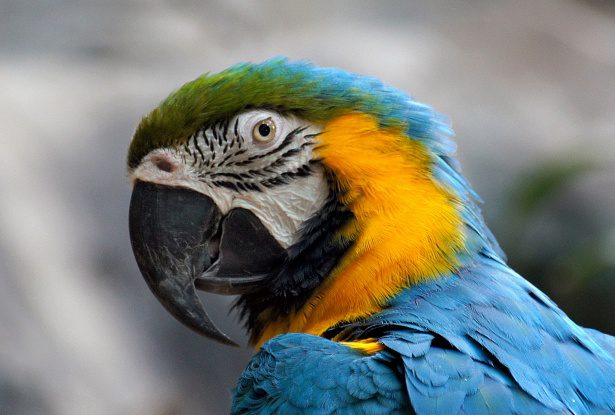
Character and features bird behavior
А Now let’s move on from appearance to character:
- Home ara is unusually sociable. He affectionate, easy to contact literally with everyone. However, still it is important to deal with the issue of socialization pet. Need from the youngest age to acquaint him with the greatest the number of people, accustom to touch, communication. It will help and facilitate the trimming procedure, and relieve your pet of fear change. Certainly, the parrot is already sociable, but it is desirable help him anyway.
- Even in the wild, macaws are enough companionable. They choose one couple for life, and even after death partners remain most often in a proud loneliness. However, these couples gather in flocks. Sometimes such flocks reach literally a hundred individuals! ara I really like talking to each other.
- inclination get attached to one person often causes macaws in captivity to choose own pet from among the owners. He’s glad everyone, but usually especially favors to one person.
- К Macaw children are treated positively, but only if the kids don’t get too haunt the birds. To pets they are also good, but, again However, this communication is also worth monitoring. For small pets like hamsters or small macaws can pose a threat, if you don’t educate them.
- Bring up macaws are often uncomplicated, since they, in addition to that are intellectual, also complaisant. However, of course, the characters are different, and even macaws can be harmful, lazy. Such character is still at the age of a chick.
- Ara very curious. And that makes them excellent partners in games and students! Training and playing them in joy. Also, macaws are often bold, not afraid to learn or try something new.
- High contact led to the fact that ara learned to communicate well. When with people it means birdie switches to human language. She is capable of incomparably learning a couple dozens of words. And, characteristically, says this parrot is quite consciously, not just repeats at random what once heard.
- Ara they might even be embarrassed! At this moment they ruffle their feathers, and their cheeks become a little pink.
Care and maintenance of the Macaw parrot home: what is important to know
Let’s talk now about what you need to know when starting macaw at home:
- Cell should be as spacious as possible. It is better to buy the most spacious cage, whatever you can find. We will not forget that some macaws are rather big dimensions, especially if they straighten wings. So, hyacinth macaws, if straighten them, they will be horizontal reach a metre! But parrots should be comfortable not only sitting, but also fly from perch to perch. Otherwise, they will develop muscle dystrophy, and in principle pets get bored. The rods must to be strong and thick, as, as we remember that the macaw has an unusually strong beak. You need to place the cage where you usually a lot of people, but away from drafts. The cage must also be equipped pull-out tray and good locks, which have a difficult opening mechanism.
- That put in a cage? Perches, of course same, in the first place. Extremely it is desirable that they be made from fruit trees. A parrot they will probably begin to gnaw, which means that wood should not cause harm. For the same reason, change the perches will have to often. diameter for large it is better to pick up a parrot at least 2 cm. In general, ideally, the paws should wrap around perch 2/3. Otherwise, either the bird will not resist, or hurt itself paws with their own claws.
- Required need bowls for food, drinkers. And for each parrot – his own, so as not to call they have a sense of competition. Plastic do not fit – macaws will quickly break them. You need to hang dishes on the sides of the cage, not near the perches, otherwise in food or the water will be litter.
- Required toys are needed, otherwise the macaw will quickly become bored when the owner is not around, and a parrot is sure to have something will break. Bells can become toys, ropes, chains, ladders, swings.
- Required you need to install a small shelter, if suddenly the parrot wants to stay alone. You also need to install a bathtub. for swimming – in the wild, macaws love perform water treatment.
- By the way about cleanliness: wash the cage and everything in it is located, it is necessary. Do you need it once a week, but clean up the excess worth every day. Approximately once a year need to be changed if necessary components of the interior of the cell with new ones. Disinfection is also needed, carry it out costs about once every six months.
- That when it comes to bathing, it’s better to take a bath add a watering can, watering from a hose, etc. That is, there must be some effect rain. The water should be slightly warm.
- Wings, as suggested by some owners, better prune a little, otherwise the macaw may fly away. If the beak or claws are too long or curved, they are also needed undercut. However, if the macaw has enough toys, he can grind them independently.
- Feed ara needs something nutritious, because these birds are very active. large macaws in nature, they mainly feed on nuts, small ones – and nuts, and grains, and fruits. As for domestic macaws, for them sells a lot of granular feed, grain mixtures. feed well balanced, but lacking phytonutrients that strengthen immunity. But grain feed cannot give calcium, vitamins. In a word, a bird feed at home a little bit for everyone – nuts, fruits, grain mixture and prepared feed. From fruit fit plums, apples, pears, bananas, oranges, papaya, mango. Vegetables, who will like the macaws – this is sweet potato, carrots, zucchini, cucumbers, leafy vegetables. You can also treat with berries – blueberries, strawberries, rowan, grapes. Avocado do not give – this product is toxic for macaws А here are pecans, hazelnuts, walnuts, almonds, canary seed, seeds sunflower – you can. Protein sometimes also do not interfere – you can find them in sprouted beans. From the greens you can give germinated grain, shrub shoots and trees, dandelion and celery leaves.
- Young macaws need to be fed three times a day, and adults twice. Overfeed the bird does not follow, but the encouragement for doing some tricks be reasonable. highly desirable teach a bird to eat at the same time time daily – it will be good component of training.
Macaw parrot training: secrets and nuances
One of long-lived macaws became Poncho, who lived for 89 years, and during this time he managed to withdraw in some films, becoming the most famous parrot actor. Of course, this is the result not only the intelligence of a bird, but also a stubborn training.
That do you need to know to train a macaw?
- So trust comes first! As we wrote above, the macaw usually chooses one pet from the owners. Let this person train the bird. It is important that she feels trust. But even such a chosen owner should not overdo it – you need to make training small, give rest to your pet, encourage him. Physical punishment and screaming are prohibited – this will destroy a trusting relationship.
- Taming should take place according to the following scheme: first, the parrot learns to take treats from his hands, then he allows him to scratch his chest, and only then – to pick him up. The treat helps a lot to get used to it. This is the initial workout.
- You should not move from one stage to another if the previous one has not been mastered. You definitely don’t need to rush – it only hurts. If a parrot studies for a long time – it’s okay, the learning ability of all macaws is different.
- You need to understand what you want to achieve from your pet. So, all macaws can master a dictionary of a couple of ten words and phrases, but red-eared ones sing best of all. The rest of the voice is rather unpleasant. You can also learn how to give a paw, raise wings, unwind toilet paper, etc.
- You need to be especially careful with macaws during their puberty – it is very easy at this time to lose the trust and authority of the bird. You need to show patience, but show who is the boss in the house. If this trust is lost at such a time, it will be difficult to regain it.
- Commands or words must be repeated clearly, loudly. It is desirable that they be short. You can show yourself what you want to achieve – macaws love to copy behavior.
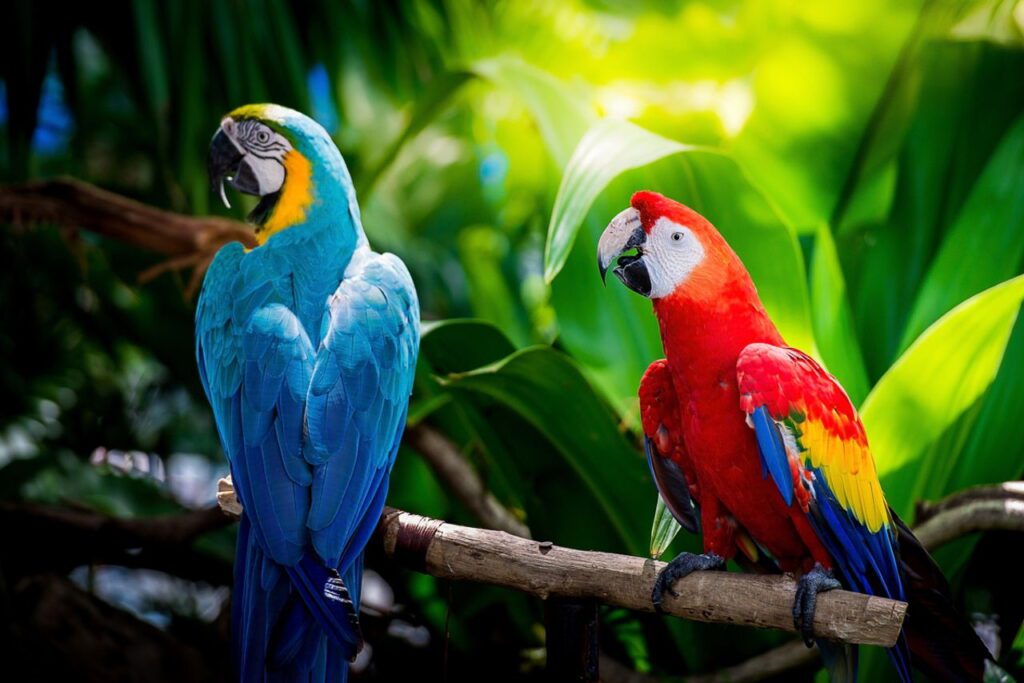
Macaw parrot breeding: nuances
That need to know about breeding macaws?
- Ara have always been considered difficult birds. In fact, the complexity determined by the fact that sex by eye is impossible – male and female nothing visually different. Gender is determined by DNA test and endoscopy. Of course, not everyone will do this. That’s why the best option is to let the bird choose a pair yourself, she will not be mistaken. Only marriage should take place in winter. It’s better to schedule it for December or January – a couple of months before the period breeding in spring.
- Optimal the age of the birds for breeding considered a period of 3 to 6 years. Although some believe that at the age of 7-8 macaws also great for leaving offspring
- Как understand that the female and male liked each other? There is a peculiar dance – leisurely steps, accompanied by nods. And then the birds seem to play in chasing.
- For future mother and her offspring make a wooden nest box. The size of the box should be at least 70x70x50 cm. The letok should not be less than 150 mm in diameter. A height the location of the notch is believed to be should be at least 25 cm.
- At the bottom aviary is best sprinkled with thick sand layer. Also recommended lay turf. Even if the chicks suddenly fall out, they should not get hurt. And in the nest itself is worth laying wood shavings or medium-sized sawdust.
- Necessary take care of the special temperature mode and suitable humidity level. Yes, the temperature should be set to about 20 degrees, and humidity – about 75-80%, no more.
- According once the female lays 3-4 eggs. Hatching lasts, as a rule, from 24 up to 28 days.
- Chicks are born completely bald. It is curious that custody of offspring ara share equally. to deposit young growth from parents is not worth while they will not be at least 4 months old.
Diseases of the Macaw parrot: let’s talk about the main ailments
Ara are considered fairly healthy birds. In the wild, for example, they are for one only a day can cover 800 km in search of food and, moreover, immediately come back! That is, these birds very hardy.
But and macaws can have health problems:
- infectious diseases – they can be caused bacteria or fungi, viruses. To for example, macaws can get infected from other pets or because the owner inadequate hygiene practices cell and everything in it. By the way, often the owners like to treat aru something tasty, what’s before entered the human mouth. For example, completely unthinking man can bite off a piece of fruit, and then feed them a pet. But contained in human saliva bacteria that can cause worth an acre. Can Ornithosis also happens, for example – an infectious disease. Also due to infections can suffer urinary tract.
- allergic reactions – they can occur on what whatever. On some fruit, on varnish for hair, sprayed in the air, on smoke. By the way, it’s not necessary a treat that suits one bird, another one will do. As in the case with a person, a parrot has allergic reactions are also individual.
- Tuberculosis – a parrot can pick up bacilli just out of thin air. Or is it the fault feed. Parrot for a long time can im getting sick so the symptoms will be time notice. Symptoms also include diarrhea, rapid breathing, drowsiness, sudden weight loss.
- Salmonellosis – a dangerous disease for a parrot, as well as for the owner. You can grab it thanks to raw food – raw eggs, for example. However, the transfers infection sometimes and water.
- problems, associated with the gastrointestinal tract – most often they occur due to poor formulated diet. For example, a person may feed the macaw too hard dairy products. Or food appears to be far from fresh.
- Lice and ticks – they are not only for seals and dogs. It’s hard not to notice it how do a parrot quickly form bald patches.
- Some warning signs like plucking feathers – this may be a signal that that Aru is not satisfied with the level of hygiene, given by the owner. Or maybe not like the diet – let’s say it’s bad balanced. It can also do this attention deficit bird opposite sex. But Anxiety most often manifests itself in lack of human attention. That’s right: macaws can literally get sick from the fact that they lack communication with owner.
Speaking about how much macaw lives for years, It should be noted that in this issue the parrot took the lead – so, he is quite able to live 50 years or more. So, in the house of Winston Churchill such The parrot lived for 114 years! Although most often these birds are limited 30-40 years, which, however, is also amazing. And the more you know about them, the better. care, the longer the macaw will delight. This is definitely a friend for life!



